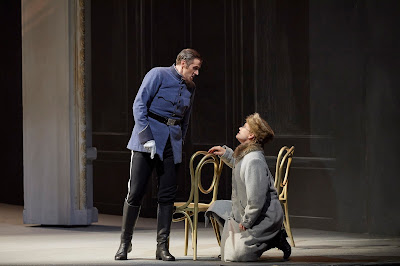James Karas
The Canadian Opera Company has made two commendable choices for its 2017
fall season. One is Richard Strauss’s lyric comedy Arabella being produced
for the first time by the COC and the other one is Donizetti’s perennial
favourite, The Elixir of Love.
A fine cast led by Erin Wall in the name role, Tomas Konieczny as
Mandryka and Jane Archibald as Zdenka in Tim Albery’s production goes a long
way in making the production highly commendable,
but no one can save the creaky and silly plot from producing twitches near the
end.
Much can be said and in fact has been written about the social and
political milieu of Arabella, the year in which it is set (Vienna in 1860), the
time in which it was written (late1920’s) and the date of its premiere in
Dresden (July 1933). But it is essentially a simple love story that demands a
serious suspension of disbelief.
Erin Wall as Arabella and Tomasz Konieczny as Mandryka in the Canadian Opera Company’s new production of Arabella, 2017. Photo: Michael Cooper
Arabella is a beautiful woman who is looking for Mr. Right. She saw a foreigner
gazing at her in the street and she fell in love with him on the spot. Mr.
Right has been found. Mandryka, Mr. Right that is, has the benefit of being
loaded, is on his way to Arabella’s residence and he is smitten by her as well.
He saw her picture.
Count Waldner, Arabella’s father, is a retired officer whose main
occupation now is gambling while looking for a rich husband for Arabella. The
word you are thinking of was not in current use at the time but the Count has
an unassailable reason for what he is doing. He is broke.
Librettist Hugo von Hofmannsthal adds complications and a sense of
urgency to the consummation of instant love, with the consonant need to achieve
the riddance of the misunderstandings, and the aversion of bankruptcy. Mr.
Right has to be found today, the last day of the Carnival, because there can be
no pursuit of marital ambitions after midnight. It is Lent and fasting is
imperative.
Michael Brandenburg as Matteo and Jane Archibald as Zdenka in Arabella. Photo: Michael Cooper
In fairness, Hofmannsthal did not live to revise the libretto and he dies
before Strauss had begun composing the music. Nevertheless, Strauss composed luscious,
melting and radiant music for the creaky libretto that lifts the opera above
the silly plot complications and common farcical elements.
Soprano Erin Wall raises Arabella above some of the traits that one would
find objectionable in our heroine. She knows nothing about this man and she
will live happily ever after in the forests of Croatia! Sure. Wall’s lustrous
voice and assured bearing make us believe Arabella and enjoy a superb performance.
Polish bass-baritone Konieczny plays the rich Croatian landowner
Mandryka, a bit of a country bumpkin, perhaps, who loves Arabella deeply even
though he knows nothing about her. We accept him as he is, thanks to Konieczny’s resonant voice and his
convincing expression of love and ignore the downside.
Soprano Jane Archibald turns in a highly commendable performance as
Arabella’s sister Zdenka. Zdenka causes all the complications that take too
long to unravel but she deserves our sympathy. She is raised as a boy because
girls are high maintenance and she is desperately in love with Matteo (a
miscast Michael Brandenburg) who is desperately in love with Arabella. You get
the idea.
Baritone John Fanning plays the gambling Count Waldner straight. Perhaps
it is the best way to present the foolish man who is pursued by creditors and
his solution is to dispose of his daughter to a rich bidder without missing a
card game. Very good work by Fanning.
Set and Costume Designer Tobias needs three sets. A hotel suite where
Arabella’s family resides, a ballroom and the hotel lobby for the final act.
The hotel suite is aggressively gray, with no wall decorations and a sofa and a
chair for furniture. The semicircular panels are turned around to create a lighter
gray scene for the ballroom. And similar work is
done for the final scene which is lit more brightly for the happy conclusion.
The sets are simple and functional and eschew extravagant
opulence. Waldner is broke, after all.
Patrick Lange conducts the COC Orchestra in this musically rich opera
with a flawed libretto.
_________________
Arabella by Richard Strauss opened on October 5 and will be
performed seven times until October 28, 2017 on various dates at the Four
Seasons Centre for the Performing Arts, 145 Queen Street West,
Toronto, Ontario. Tel: 416-363-6671. www.coc.ca















